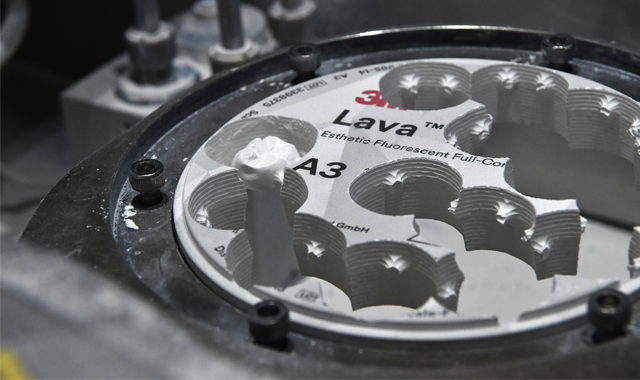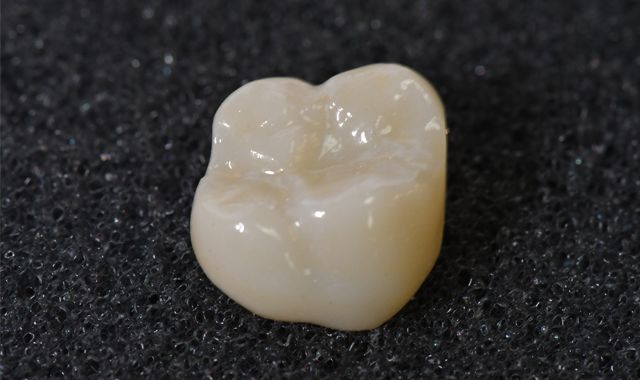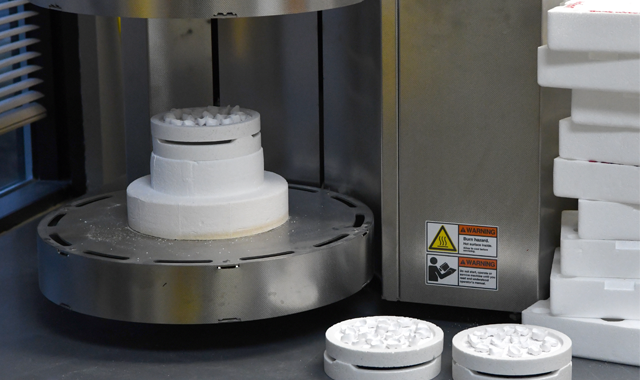6 steps to a great crown
A technical overview of CAD/CAM procedures, featuring 3M Lava Esthetic Fluorescent Full-Contour Zirconia.

The goal of this article is to provide a general overview of the basic processes involved in producing a 3M™ Lava™ Esthetic Fluorescent Full-Contour Zirconia crown in the dental laboratory. The differences in production processes compared to a conventional (non-preshaded) zirconia material will be noted, as well as the many benefits our lab has realized in using this new zirconia.
Scanning
The first step in any digital workflow is creating digital versions of the patient’s dentition. There are two major ways to achieve this: First, receive a digital impression scan which the doctor has taken in the clinic. Second, receive a traditional impression from the clinic and scan it with a laboratory scanner.
A completed crown

The first option, if done properly, should result in an accurate digital model of the patient’s teeth straight from the chair. With the second option, a traditional stone
model will still need to be poured from the impression, which is then scanned using the lab scanner - we use the Identica T500 from Medit. Either option can be a viable way to digitize the dentition, depending on the individual laboratory’s production levels and applications.
Designing
Once a digital model is available, it can be imported to a dental design software for the design process. It is important to be cognizant of the varying limitations of not only the material in use but also the individual milling machine that will mill the case. Time spent on remakes and adjustments can be greatly saved through a knowledgeable design process, making this one of the most important processes in the digital workflow.
Nesting
After designing procedures are finished, the 3D data of the restoration is transferred to a CAM software for nesting and calculation. A CAM software reads the data of the restoration file and creates directions for the milling machine to follow according to the preset settings and milling strategy.
Related article: How to place an anterior implant using a digital workflow
Nesting is a process in which the technician places the restorations within the zirconia disc, or puck, taking into account the varying limitations of a milling process (such as undercuts). Proper nesting is absolutely crucial in ensuring that the resulting restoration is of a desirable outcome.
For zirconia materials with a built-in shade gradient, such as Lava Esthetic zirconia, it should be noted that in order for the shade gradient of the disc to be properly utilized, all restorations should be nested vertically. Once nesting and sprue placement are finished, the milling is then calculated by the CAM software and the milling process begins.
Milling
Proper maintenance of the milling machines and the accompanying tools, such as burs, will ensure that the milling quality does not degrade or fail over time. Regular cleaning, calibrating, and tool exchanges are all important forms of maintenance. As precision tools, milling machines can be sensitive to a variety of factors, such as electrical output, air pressure, various sensors, mechanical moving parts, etc. It is important to understand these factors as best as one can and have reliable support from the equipment suppliers. Again, as a zirconia with a built-in shade gradient, it’s important to place the discs into the milling machine in the correct direction.
Related article: What CAM software really does
Sintering
The conventional, non-preshaded zirconia, widely in use today, requires a coloring phase during production in order for the final product to have proper coloration. Prior to the sintering stage, various dyeing liquids are applied to individual cases to match the prescribed shade. In our lab’s opinion, one of the greatest benefits of using a zirconia with a built-in shade gradient, such as Lava Esthetic zirconia, is that these shading steps and drying times can be entirely bypassed, saving valuable resources during production. On average, this saves about two hours of productiontimeper cycle, a drastic improvement!
Sintering

Additionally, there are multiple other benefits to avoiding in-lab coloring. Coloring liquids are, in general, harmful to the longevity of the heating elements in sintering machines. By using preshaded zirconia, such as Lava Esthetic zirconia, laboratories can expect to have longer-lasting heating elements, which can be burdensome to exchange often.
When using coloring dyes on zirconia the technician is applying a layer of color on top of the restoration, rather than throughout the entire material. Excessive removal of material during contact/bite check can remove that colored layer and expose the original zirconia color. Because Lava Esthetic’s shading runs throughout the entire material, this can be completely avoided and the resulting restoration achieves greater likeness to natural human teeth with its fluorescence and translucency; however, it should be noted that due to its high translucency, opaque liners are not recommended for Lava Esthetic zirconia, as the white of the opaque liner can overwhelm the restoration.
Also, just as with milling machines, sintering machines require regular maintenance in order to function properly. Running cleaning cycles and exchanging old heating elements are important in allowing the machine to reach the appropriate temperature to sinter the zirconia. Lava Esthetic zirconia should be sintered at 1500°C. When compared to other zirconia materials, the sintering process for this material can save another two hours! Once sintering is finished, the restorations can be finished and glazed.
Related article: How the digital workflow will enhance communication and reliability
Contact/bite
Completely digital modeless cases, while certainly viable depending on the doctor’s preference and the complexity of the case, are not always recommended. While being a CAD/CAM material, zirconia restorations in our lab still involve traditional methods of checking for margin, contact and occlusion. Chair time is saved when this procedure is done in the lab.
Refining contact/bite

Lava Esthetic zirconia provides very high translucency and shades that are true to the VITA Classic Shades, but are also more glass-like in material characteristics than conventional zirconia. This means some indication limitations (we do not recommend Lava Esthetic zirconia for cases with knife edge margins). For adjustments, we recommend using green stone point burs instead of diamond points. For finishing, silicon material burs are recommended.
Conclusion
CAD/CAM procedures and materials are already an integral part of many dental practices. As new innovations in materials enter the industry - continuing to push CAD/CAM methods faster, more convenient, and more profitable - it is important for laboratories to incorporate these improvements to provide the best service to the doctors, and the best clinical outcomes to the patients. Investing in research and finding reliable partners is a key to being able to do so. Whether your lab is completely new to CAD/CAM or already a veteran, it’s important to always seek to take the next step forward.